Impact of Diabetes Mellitus on Society and Individuals
VerifiedAdded on 2022/10/02
|10
|2942
|215
AI Summary
The report analyzes the impact of diabetes mellitus on society and individuals through relevant physiology, anatomy and pathophysiology. It discusses the current and new treatments, social impact, impact on society, public initiatives, and more.
Contribute Materials
Your contribution can guide someone’s learning journey. Share your
documents today.

Health and Society
Student's Name:
Student's ID:
Student's Name:
Student's ID:
Secure Best Marks with AI Grader
Need help grading? Try our AI Grader for instant feedback on your assignments.
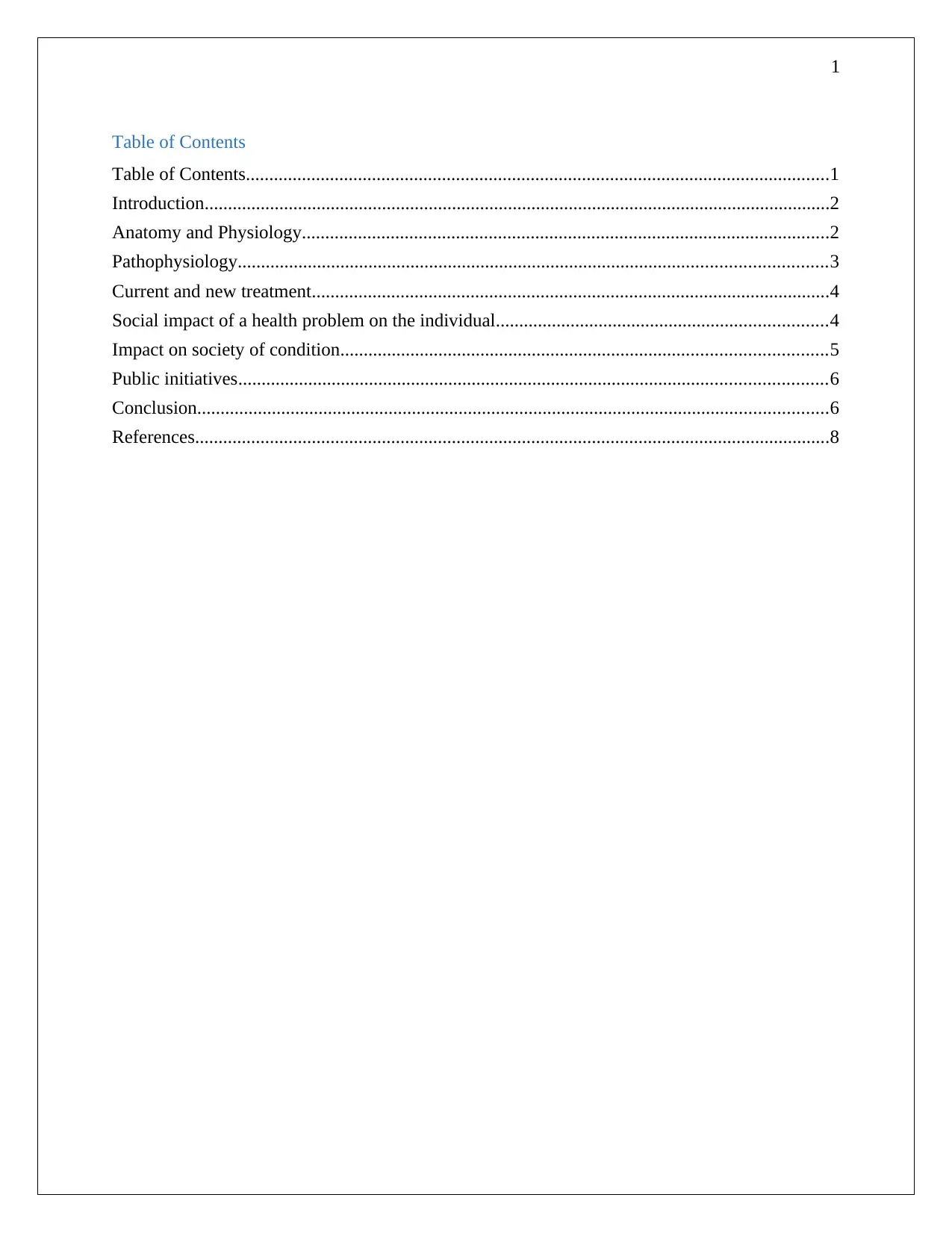
1
Table of Contents
Table of Contents.............................................................................................................................1
Introduction......................................................................................................................................2
Anatomy and Physiology.................................................................................................................2
Pathophysiology..............................................................................................................................3
Current and new treatment...............................................................................................................4
Social impact of a health problem on the individual.......................................................................4
Impact on society of condition........................................................................................................5
Public initiatives..............................................................................................................................6
Conclusion.......................................................................................................................................6
References........................................................................................................................................8
Table of Contents
Table of Contents.............................................................................................................................1
Introduction......................................................................................................................................2
Anatomy and Physiology.................................................................................................................2
Pathophysiology..............................................................................................................................3
Current and new treatment...............................................................................................................4
Social impact of a health problem on the individual.......................................................................4
Impact on society of condition........................................................................................................5
Public initiatives..............................................................................................................................6
Conclusion.......................................................................................................................................6
References........................................................................................................................................8
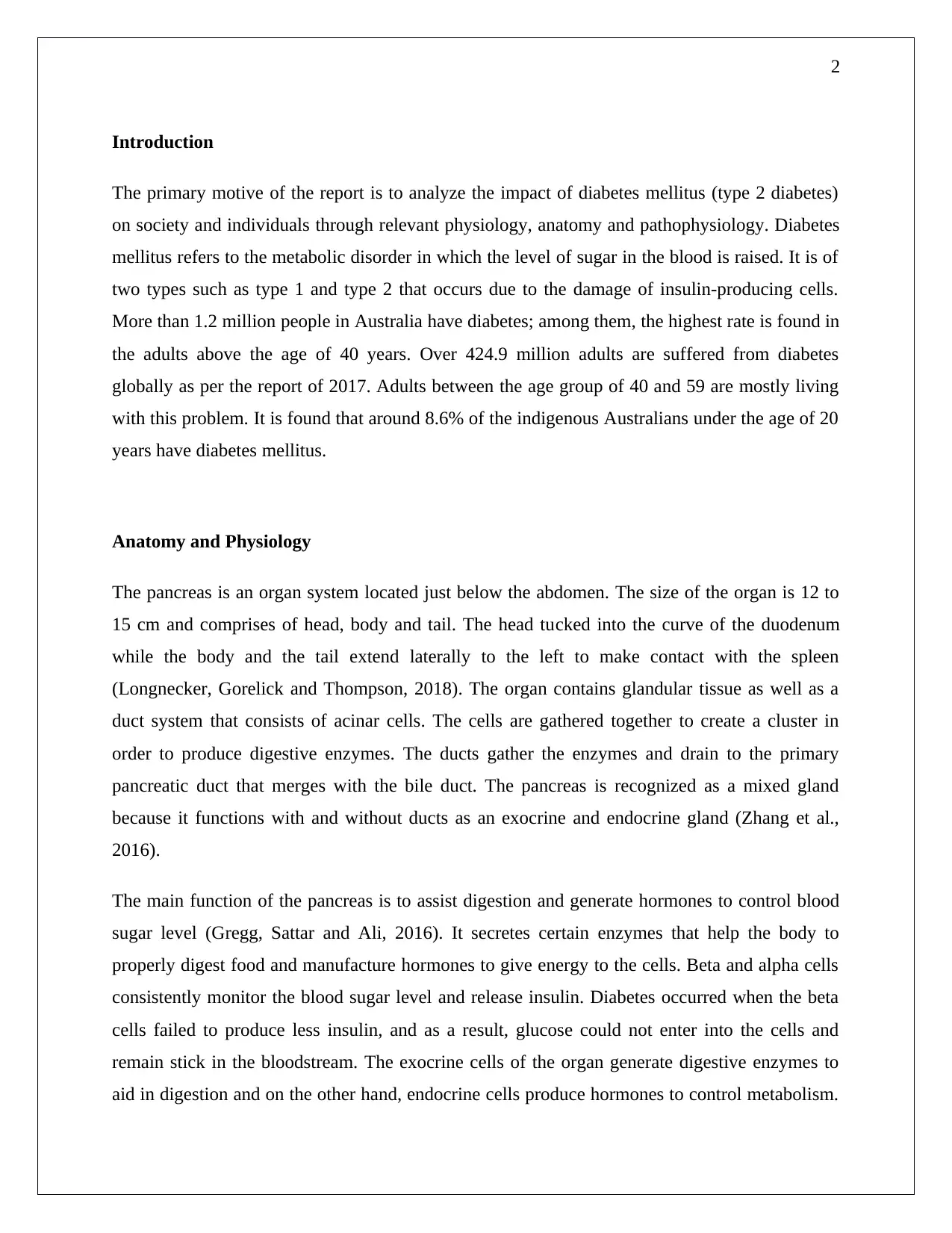
2
Introduction
The primary motive of the report is to analyze the impact of diabetes mellitus (type 2 diabetes)
on society and individuals through relevant physiology, anatomy and pathophysiology. Diabetes
mellitus refers to the metabolic disorder in which the level of sugar in the blood is raised. It is of
two types such as type 1 and type 2 that occurs due to the damage of insulin-producing cells.
More than 1.2 million people in Australia have diabetes; among them, the highest rate is found in
the adults above the age of 40 years. Over 424.9 million adults are suffered from diabetes
globally as per the report of 2017. Adults between the age group of 40 and 59 are mostly living
with this problem. It is found that around 8.6% of the indigenous Australians under the age of 20
years have diabetes mellitus.
Anatomy and Physiology
The pancreas is an organ system located just below the abdomen. The size of the organ is 12 to
15 cm and comprises of head, body and tail. The head tucked into the curve of the duodenum
while the body and the tail extend laterally to the left to make contact with the spleen
(Longnecker, Gorelick and Thompson, 2018). The organ contains glandular tissue as well as a
duct system that consists of acinar cells. The cells are gathered together to create a cluster in
order to produce digestive enzymes. The ducts gather the enzymes and drain to the primary
pancreatic duct that merges with the bile duct. The pancreas is recognized as a mixed gland
because it functions with and without ducts as an exocrine and endocrine gland (Zhang et al.,
2016).
The main function of the pancreas is to assist digestion and generate hormones to control blood
sugar level (Gregg, Sattar and Ali, 2016). It secretes certain enzymes that help the body to
properly digest food and manufacture hormones to give energy to the cells. Beta and alpha cells
consistently monitor the blood sugar level and release insulin. Diabetes occurred when the beta
cells failed to produce less insulin, and as a result, glucose could not enter into the cells and
remain stick in the bloodstream. The exocrine cells of the organ generate digestive enzymes to
aid in digestion and on the other hand, endocrine cells produce hormones to control metabolism.
Introduction
The primary motive of the report is to analyze the impact of diabetes mellitus (type 2 diabetes)
on society and individuals through relevant physiology, anatomy and pathophysiology. Diabetes
mellitus refers to the metabolic disorder in which the level of sugar in the blood is raised. It is of
two types such as type 1 and type 2 that occurs due to the damage of insulin-producing cells.
More than 1.2 million people in Australia have diabetes; among them, the highest rate is found in
the adults above the age of 40 years. Over 424.9 million adults are suffered from diabetes
globally as per the report of 2017. Adults between the age group of 40 and 59 are mostly living
with this problem. It is found that around 8.6% of the indigenous Australians under the age of 20
years have diabetes mellitus.
Anatomy and Physiology
The pancreas is an organ system located just below the abdomen. The size of the organ is 12 to
15 cm and comprises of head, body and tail. The head tucked into the curve of the duodenum
while the body and the tail extend laterally to the left to make contact with the spleen
(Longnecker, Gorelick and Thompson, 2018). The organ contains glandular tissue as well as a
duct system that consists of acinar cells. The cells are gathered together to create a cluster in
order to produce digestive enzymes. The ducts gather the enzymes and drain to the primary
pancreatic duct that merges with the bile duct. The pancreas is recognized as a mixed gland
because it functions with and without ducts as an exocrine and endocrine gland (Zhang et al.,
2016).
The main function of the pancreas is to assist digestion and generate hormones to control blood
sugar level (Gregg, Sattar and Ali, 2016). It secretes certain enzymes that help the body to
properly digest food and manufacture hormones to give energy to the cells. Beta and alpha cells
consistently monitor the blood sugar level and release insulin. Diabetes occurred when the beta
cells failed to produce less insulin, and as a result, glucose could not enter into the cells and
remain stick in the bloodstream. The exocrine cells of the organ generate digestive enzymes to
aid in digestion and on the other hand, endocrine cells produce hormones to control metabolism.
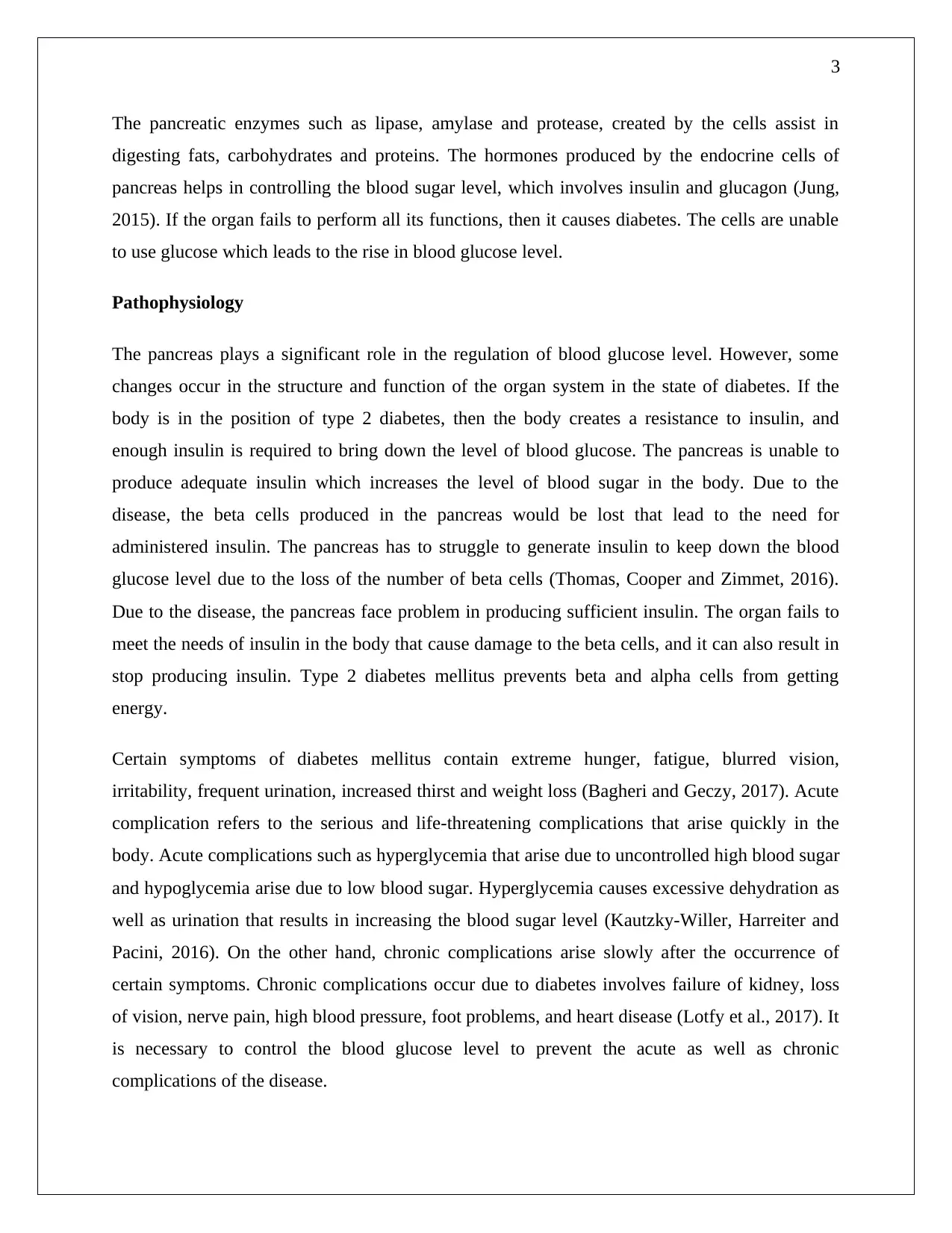
3
The pancreatic enzymes such as lipase, amylase and protease, created by the cells assist in
digesting fats, carbohydrates and proteins. The hormones produced by the endocrine cells of
pancreas helps in controlling the blood sugar level, which involves insulin and glucagon (Jung,
2015). If the organ fails to perform all its functions, then it causes diabetes. The cells are unable
to use glucose which leads to the rise in blood glucose level.
Pathophysiology
The pancreas plays a significant role in the regulation of blood glucose level. However, some
changes occur in the structure and function of the organ system in the state of diabetes. If the
body is in the position of type 2 diabetes, then the body creates a resistance to insulin, and
enough insulin is required to bring down the level of blood glucose. The pancreas is unable to
produce adequate insulin which increases the level of blood sugar in the body. Due to the
disease, the beta cells produced in the pancreas would be lost that lead to the need for
administered insulin. The pancreas has to struggle to generate insulin to keep down the blood
glucose level due to the loss of the number of beta cells (Thomas, Cooper and Zimmet, 2016).
Due to the disease, the pancreas face problem in producing sufficient insulin. The organ fails to
meet the needs of insulin in the body that cause damage to the beta cells, and it can also result in
stop producing insulin. Type 2 diabetes mellitus prevents beta and alpha cells from getting
energy.
Certain symptoms of diabetes mellitus contain extreme hunger, fatigue, blurred vision,
irritability, frequent urination, increased thirst and weight loss (Bagheri and Geczy, 2017). Acute
complication refers to the serious and life-threatening complications that arise quickly in the
body. Acute complications such as hyperglycemia that arise due to uncontrolled high blood sugar
and hypoglycemia arise due to low blood sugar. Hyperglycemia causes excessive dehydration as
well as urination that results in increasing the blood sugar level (Kautzky-Willer, Harreiter and
Pacini, 2016). On the other hand, chronic complications arise slowly after the occurrence of
certain symptoms. Chronic complications occur due to diabetes involves failure of kidney, loss
of vision, nerve pain, high blood pressure, foot problems, and heart disease (Lotfy et al., 2017). It
is necessary to control the blood glucose level to prevent the acute as well as chronic
complications of the disease.
The pancreatic enzymes such as lipase, amylase and protease, created by the cells assist in
digesting fats, carbohydrates and proteins. The hormones produced by the endocrine cells of
pancreas helps in controlling the blood sugar level, which involves insulin and glucagon (Jung,
2015). If the organ fails to perform all its functions, then it causes diabetes. The cells are unable
to use glucose which leads to the rise in blood glucose level.
Pathophysiology
The pancreas plays a significant role in the regulation of blood glucose level. However, some
changes occur in the structure and function of the organ system in the state of diabetes. If the
body is in the position of type 2 diabetes, then the body creates a resistance to insulin, and
enough insulin is required to bring down the level of blood glucose. The pancreas is unable to
produce adequate insulin which increases the level of blood sugar in the body. Due to the
disease, the beta cells produced in the pancreas would be lost that lead to the need for
administered insulin. The pancreas has to struggle to generate insulin to keep down the blood
glucose level due to the loss of the number of beta cells (Thomas, Cooper and Zimmet, 2016).
Due to the disease, the pancreas face problem in producing sufficient insulin. The organ fails to
meet the needs of insulin in the body that cause damage to the beta cells, and it can also result in
stop producing insulin. Type 2 diabetes mellitus prevents beta and alpha cells from getting
energy.
Certain symptoms of diabetes mellitus contain extreme hunger, fatigue, blurred vision,
irritability, frequent urination, increased thirst and weight loss (Bagheri and Geczy, 2017). Acute
complication refers to the serious and life-threatening complications that arise quickly in the
body. Acute complications such as hyperglycemia that arise due to uncontrolled high blood sugar
and hypoglycemia arise due to low blood sugar. Hyperglycemia causes excessive dehydration as
well as urination that results in increasing the blood sugar level (Kautzky-Willer, Harreiter and
Pacini, 2016). On the other hand, chronic complications arise slowly after the occurrence of
certain symptoms. Chronic complications occur due to diabetes involves failure of kidney, loss
of vision, nerve pain, high blood pressure, foot problems, and heart disease (Lotfy et al., 2017). It
is necessary to control the blood glucose level to prevent the acute as well as chronic
complications of the disease.
Secure Best Marks with AI Grader
Need help grading? Try our AI Grader for instant feedback on your assignments.
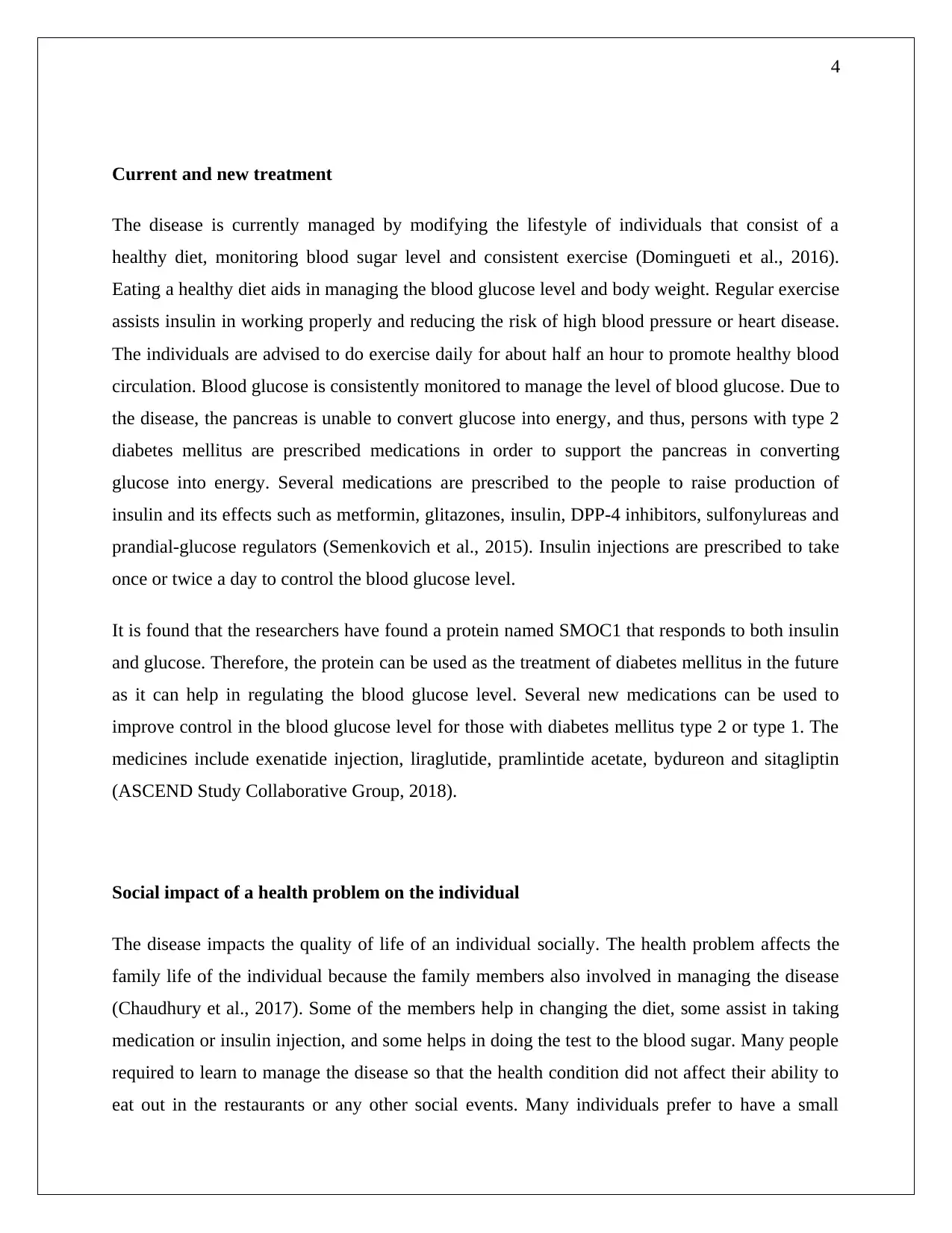
4
Current and new treatment
The disease is currently managed by modifying the lifestyle of individuals that consist of a
healthy diet, monitoring blood sugar level and consistent exercise (Domingueti et al., 2016).
Eating a healthy diet aids in managing the blood glucose level and body weight. Regular exercise
assists insulin in working properly and reducing the risk of high blood pressure or heart disease.
The individuals are advised to do exercise daily for about half an hour to promote healthy blood
circulation. Blood glucose is consistently monitored to manage the level of blood glucose. Due to
the disease, the pancreas is unable to convert glucose into energy, and thus, persons with type 2
diabetes mellitus are prescribed medications in order to support the pancreas in converting
glucose into energy. Several medications are prescribed to the people to raise production of
insulin and its effects such as metformin, glitazones, insulin, DPP-4 inhibitors, sulfonylureas and
prandial-glucose regulators (Semenkovich et al., 2015). Insulin injections are prescribed to take
once or twice a day to control the blood glucose level.
It is found that the researchers have found a protein named SMOC1 that responds to both insulin
and glucose. Therefore, the protein can be used as the treatment of diabetes mellitus in the future
as it can help in regulating the blood glucose level. Several new medications can be used to
improve control in the blood glucose level for those with diabetes mellitus type 2 or type 1. The
medicines include exenatide injection, liraglutide, pramlintide acetate, bydureon and sitagliptin
(ASCEND Study Collaborative Group, 2018).
Social impact of a health problem on the individual
The disease impacts the quality of life of an individual socially. The health problem affects the
family life of the individual because the family members also involved in managing the disease
(Chaudhury et al., 2017). Some of the members help in changing the diet, some assist in taking
medication or insulin injection, and some helps in doing the test to the blood sugar. Many people
required to learn to manage the disease so that the health condition did not affect their ability to
eat out in the restaurants or any other social events. Many individuals prefer to have a small
Current and new treatment
The disease is currently managed by modifying the lifestyle of individuals that consist of a
healthy diet, monitoring blood sugar level and consistent exercise (Domingueti et al., 2016).
Eating a healthy diet aids in managing the blood glucose level and body weight. Regular exercise
assists insulin in working properly and reducing the risk of high blood pressure or heart disease.
The individuals are advised to do exercise daily for about half an hour to promote healthy blood
circulation. Blood glucose is consistently monitored to manage the level of blood glucose. Due to
the disease, the pancreas is unable to convert glucose into energy, and thus, persons with type 2
diabetes mellitus are prescribed medications in order to support the pancreas in converting
glucose into energy. Several medications are prescribed to the people to raise production of
insulin and its effects such as metformin, glitazones, insulin, DPP-4 inhibitors, sulfonylureas and
prandial-glucose regulators (Semenkovich et al., 2015). Insulin injections are prescribed to take
once or twice a day to control the blood glucose level.
It is found that the researchers have found a protein named SMOC1 that responds to both insulin
and glucose. Therefore, the protein can be used as the treatment of diabetes mellitus in the future
as it can help in regulating the blood glucose level. Several new medications can be used to
improve control in the blood glucose level for those with diabetes mellitus type 2 or type 1. The
medicines include exenatide injection, liraglutide, pramlintide acetate, bydureon and sitagliptin
(ASCEND Study Collaborative Group, 2018).
Social impact of a health problem on the individual
The disease impacts the quality of life of an individual socially. The health problem affects the
family life of the individual because the family members also involved in managing the disease
(Chaudhury et al., 2017). Some of the members help in changing the diet, some assist in taking
medication or insulin injection, and some helps in doing the test to the blood sugar. Many people
required to learn to manage the disease so that the health condition did not affect their ability to
eat out in the restaurants or any other social events. Many individuals prefer to have a small

5
amount of food and avoid sweet as well as spicy foods. Moreover, people feel it awkward to give
themselves injections when out for socializing. While travelling to abroad or far place, the
individuals have to take twice the amount of medication required.
The health problem also affects the working life of the individual by increasing absenteeism,
reducing productivity at work, and discrimination from employers or peers. The disease affects
the quality of life of the individual by affecting the areas of working ability or family
functioning.
Impact on society of condition
Diabetes mellitus generates crucial impact on the work productivity of individuals in
employment. The persons with the health condition face work loss and other limitations related
to the work and that affect their work productivity. The condition reduces the performance of the
people in the workplace and causes unemployment. The cost incurred in the treatment and
prevention of diabetes is too high due to the rise in the number of affected individuals. The acute
and chronic complications caused due to the health problem highly impact the hospitalization of
the individuals (Li et al., 2017). They have to stay for a longer period which costs a huge amount
of money to them.
People with diabetes increase the cost of hospitalization that leads to an increase in financial
expenditure of the health care system (Schnell et al., 2017). It is found that people having
diabetes mellitus have to visit doctors and other specialists frequently for a regular checkup and
monitoring the level of blood glucose. Hence, they have to spend a huge amount of money on
their treatment. Besides this, the acute and chronic complications of health condition increase the
risk of hospitalization for heart failure. The cost of care and special programs for persons with
diabetes accounts an average cost of $16,750 per year. Hence, the health problem and its
complications decrease the productivity of costs in the health care system and health care
programs. It is identified that an increased cost per capita cost of care for the health issue creates
a challenge for controlling the costs.
amount of food and avoid sweet as well as spicy foods. Moreover, people feel it awkward to give
themselves injections when out for socializing. While travelling to abroad or far place, the
individuals have to take twice the amount of medication required.
The health problem also affects the working life of the individual by increasing absenteeism,
reducing productivity at work, and discrimination from employers or peers. The disease affects
the quality of life of the individual by affecting the areas of working ability or family
functioning.
Impact on society of condition
Diabetes mellitus generates crucial impact on the work productivity of individuals in
employment. The persons with the health condition face work loss and other limitations related
to the work and that affect their work productivity. The condition reduces the performance of the
people in the workplace and causes unemployment. The cost incurred in the treatment and
prevention of diabetes is too high due to the rise in the number of affected individuals. The acute
and chronic complications caused due to the health problem highly impact the hospitalization of
the individuals (Li et al., 2017). They have to stay for a longer period which costs a huge amount
of money to them.
People with diabetes increase the cost of hospitalization that leads to an increase in financial
expenditure of the health care system (Schnell et al., 2017). It is found that people having
diabetes mellitus have to visit doctors and other specialists frequently for a regular checkup and
monitoring the level of blood glucose. Hence, they have to spend a huge amount of money on
their treatment. Besides this, the acute and chronic complications of health condition increase the
risk of hospitalization for heart failure. The cost of care and special programs for persons with
diabetes accounts an average cost of $16,750 per year. Hence, the health problem and its
complications decrease the productivity of costs in the health care system and health care
programs. It is identified that an increased cost per capita cost of care for the health issue creates
a challenge for controlling the costs.
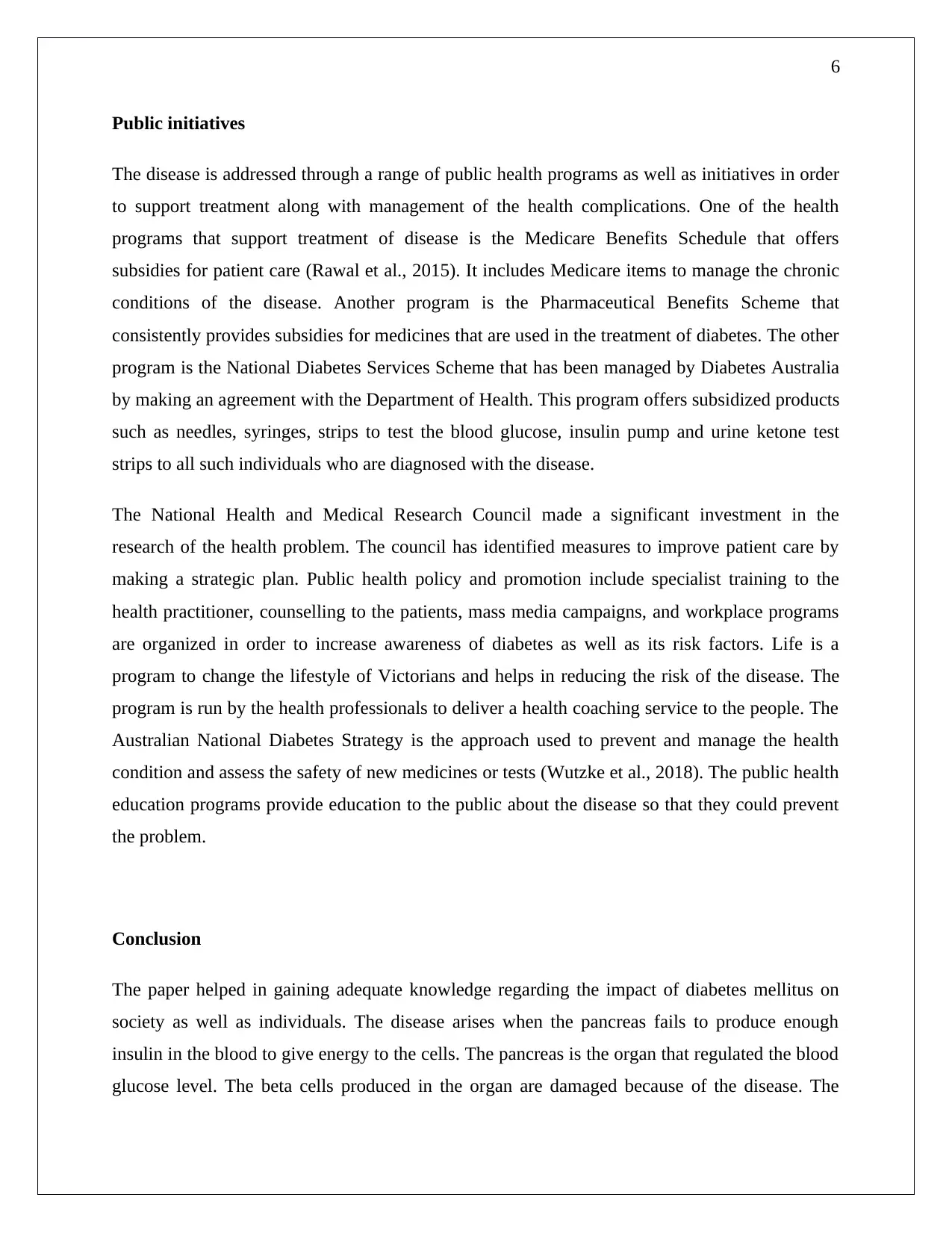
6
Public initiatives
The disease is addressed through a range of public health programs as well as initiatives in order
to support treatment along with management of the health complications. One of the health
programs that support treatment of disease is the Medicare Benefits Schedule that offers
subsidies for patient care (Rawal et al., 2015). It includes Medicare items to manage the chronic
conditions of the disease. Another program is the Pharmaceutical Benefits Scheme that
consistently provides subsidies for medicines that are used in the treatment of diabetes. The other
program is the National Diabetes Services Scheme that has been managed by Diabetes Australia
by making an agreement with the Department of Health. This program offers subsidized products
such as needles, syringes, strips to test the blood glucose, insulin pump and urine ketone test
strips to all such individuals who are diagnosed with the disease.
The National Health and Medical Research Council made a significant investment in the
research of the health problem. The council has identified measures to improve patient care by
making a strategic plan. Public health policy and promotion include specialist training to the
health practitioner, counselling to the patients, mass media campaigns, and workplace programs
are organized in order to increase awareness of diabetes as well as its risk factors. Life is a
program to change the lifestyle of Victorians and helps in reducing the risk of the disease. The
program is run by the health professionals to deliver a health coaching service to the people. The
Australian National Diabetes Strategy is the approach used to prevent and manage the health
condition and assess the safety of new medicines or tests (Wutzke et al., 2018). The public health
education programs provide education to the public about the disease so that they could prevent
the problem.
Conclusion
The paper helped in gaining adequate knowledge regarding the impact of diabetes mellitus on
society as well as individuals. The disease arises when the pancreas fails to produce enough
insulin in the blood to give energy to the cells. The pancreas is the organ that regulated the blood
glucose level. The beta cells produced in the organ are damaged because of the disease. The
Public initiatives
The disease is addressed through a range of public health programs as well as initiatives in order
to support treatment along with management of the health complications. One of the health
programs that support treatment of disease is the Medicare Benefits Schedule that offers
subsidies for patient care (Rawal et al., 2015). It includes Medicare items to manage the chronic
conditions of the disease. Another program is the Pharmaceutical Benefits Scheme that
consistently provides subsidies for medicines that are used in the treatment of diabetes. The other
program is the National Diabetes Services Scheme that has been managed by Diabetes Australia
by making an agreement with the Department of Health. This program offers subsidized products
such as needles, syringes, strips to test the blood glucose, insulin pump and urine ketone test
strips to all such individuals who are diagnosed with the disease.
The National Health and Medical Research Council made a significant investment in the
research of the health problem. The council has identified measures to improve patient care by
making a strategic plan. Public health policy and promotion include specialist training to the
health practitioner, counselling to the patients, mass media campaigns, and workplace programs
are organized in order to increase awareness of diabetes as well as its risk factors. Life is a
program to change the lifestyle of Victorians and helps in reducing the risk of the disease. The
program is run by the health professionals to deliver a health coaching service to the people. The
Australian National Diabetes Strategy is the approach used to prevent and manage the health
condition and assess the safety of new medicines or tests (Wutzke et al., 2018). The public health
education programs provide education to the public about the disease so that they could prevent
the problem.
Conclusion
The paper helped in gaining adequate knowledge regarding the impact of diabetes mellitus on
society as well as individuals. The disease arises when the pancreas fails to produce enough
insulin in the blood to give energy to the cells. The pancreas is the organ that regulated the blood
glucose level. The beta cells produced in the organ are damaged because of the disease. The
Paraphrase This Document
Need a fresh take? Get an instant paraphrase of this document with our AI Paraphraser

7
health problem consists of both acute and chronic complications such as blindness, kidney
failure, hyperglycemia and heart disease. Several treatments are made to treat and manage the
disease such as insulin injection, metformin medication, exercise and healthy diet. It impacts the
working as well as the family life of the people by decreasing their productivity in work and
changing their lifestyle.
health problem consists of both acute and chronic complications such as blindness, kidney
failure, hyperglycemia and heart disease. Several treatments are made to treat and manage the
disease such as insulin injection, metformin medication, exercise and healthy diet. It impacts the
working as well as the family life of the people by decreasing their productivity in work and
changing their lifestyle.
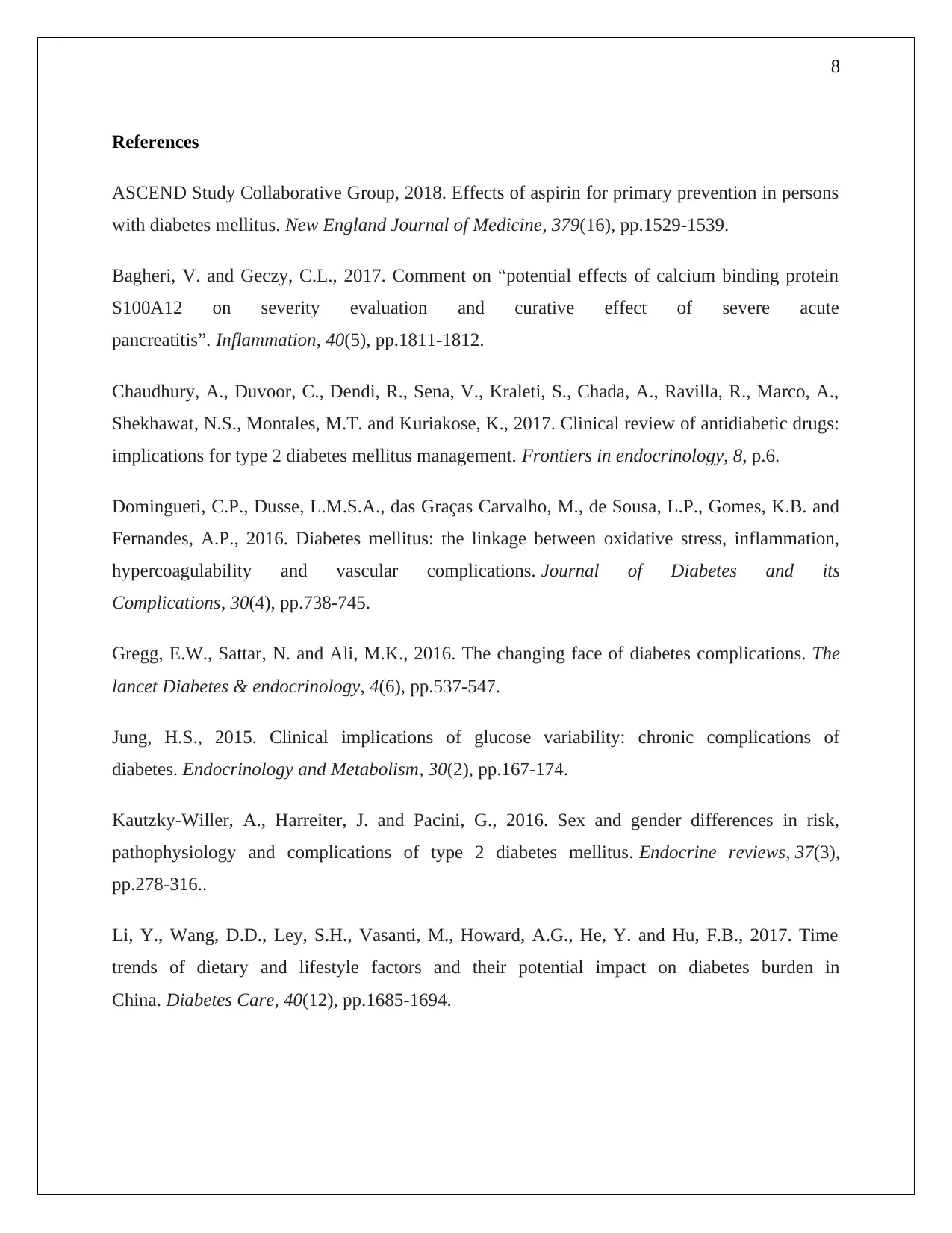
8
References
ASCEND Study Collaborative Group, 2018. Effects of aspirin for primary prevention in persons
with diabetes mellitus. New England Journal of Medicine, 379(16), pp.1529-1539.
Bagheri, V. and Geczy, C.L., 2017. Comment on “potential effects of calcium binding protein
S100A12 on severity evaluation and curative effect of severe acute
pancreatitis”. Inflammation, 40(5), pp.1811-1812.
Chaudhury, A., Duvoor, C., Dendi, R., Sena, V., Kraleti, S., Chada, A., Ravilla, R., Marco, A.,
Shekhawat, N.S., Montales, M.T. and Kuriakose, K., 2017. Clinical review of antidiabetic drugs:
implications for type 2 diabetes mellitus management. Frontiers in endocrinology, 8, p.6.
Domingueti, C.P., Dusse, L.M.S.A., das Graças Carvalho, M., de Sousa, L.P., Gomes, K.B. and
Fernandes, A.P., 2016. Diabetes mellitus: the linkage between oxidative stress, inflammation,
hypercoagulability and vascular complications. Journal of Diabetes and its
Complications, 30(4), pp.738-745.
Gregg, E.W., Sattar, N. and Ali, M.K., 2016. The changing face of diabetes complications. The
lancet Diabetes & endocrinology, 4(6), pp.537-547.
Jung, H.S., 2015. Clinical implications of glucose variability: chronic complications of
diabetes. Endocrinology and Metabolism, 30(2), pp.167-174.
Kautzky-Willer, A., Harreiter, J. and Pacini, G., 2016. Sex and gender differences in risk,
pathophysiology and complications of type 2 diabetes mellitus. Endocrine reviews, 37(3),
pp.278-316..
Li, Y., Wang, D.D., Ley, S.H., Vasanti, M., Howard, A.G., He, Y. and Hu, F.B., 2017. Time
trends of dietary and lifestyle factors and their potential impact on diabetes burden in
China. Diabetes Care, 40(12), pp.1685-1694.
References
ASCEND Study Collaborative Group, 2018. Effects of aspirin for primary prevention in persons
with diabetes mellitus. New England Journal of Medicine, 379(16), pp.1529-1539.
Bagheri, V. and Geczy, C.L., 2017. Comment on “potential effects of calcium binding protein
S100A12 on severity evaluation and curative effect of severe acute
pancreatitis”. Inflammation, 40(5), pp.1811-1812.
Chaudhury, A., Duvoor, C., Dendi, R., Sena, V., Kraleti, S., Chada, A., Ravilla, R., Marco, A.,
Shekhawat, N.S., Montales, M.T. and Kuriakose, K., 2017. Clinical review of antidiabetic drugs:
implications for type 2 diabetes mellitus management. Frontiers in endocrinology, 8, p.6.
Domingueti, C.P., Dusse, L.M.S.A., das Graças Carvalho, M., de Sousa, L.P., Gomes, K.B. and
Fernandes, A.P., 2016. Diabetes mellitus: the linkage between oxidative stress, inflammation,
hypercoagulability and vascular complications. Journal of Diabetes and its
Complications, 30(4), pp.738-745.
Gregg, E.W., Sattar, N. and Ali, M.K., 2016. The changing face of diabetes complications. The
lancet Diabetes & endocrinology, 4(6), pp.537-547.
Jung, H.S., 2015. Clinical implications of glucose variability: chronic complications of
diabetes. Endocrinology and Metabolism, 30(2), pp.167-174.
Kautzky-Willer, A., Harreiter, J. and Pacini, G., 2016. Sex and gender differences in risk,
pathophysiology and complications of type 2 diabetes mellitus. Endocrine reviews, 37(3),
pp.278-316..
Li, Y., Wang, D.D., Ley, S.H., Vasanti, M., Howard, A.G., He, Y. and Hu, F.B., 2017. Time
trends of dietary and lifestyle factors and their potential impact on diabetes burden in
China. Diabetes Care, 40(12), pp.1685-1694.
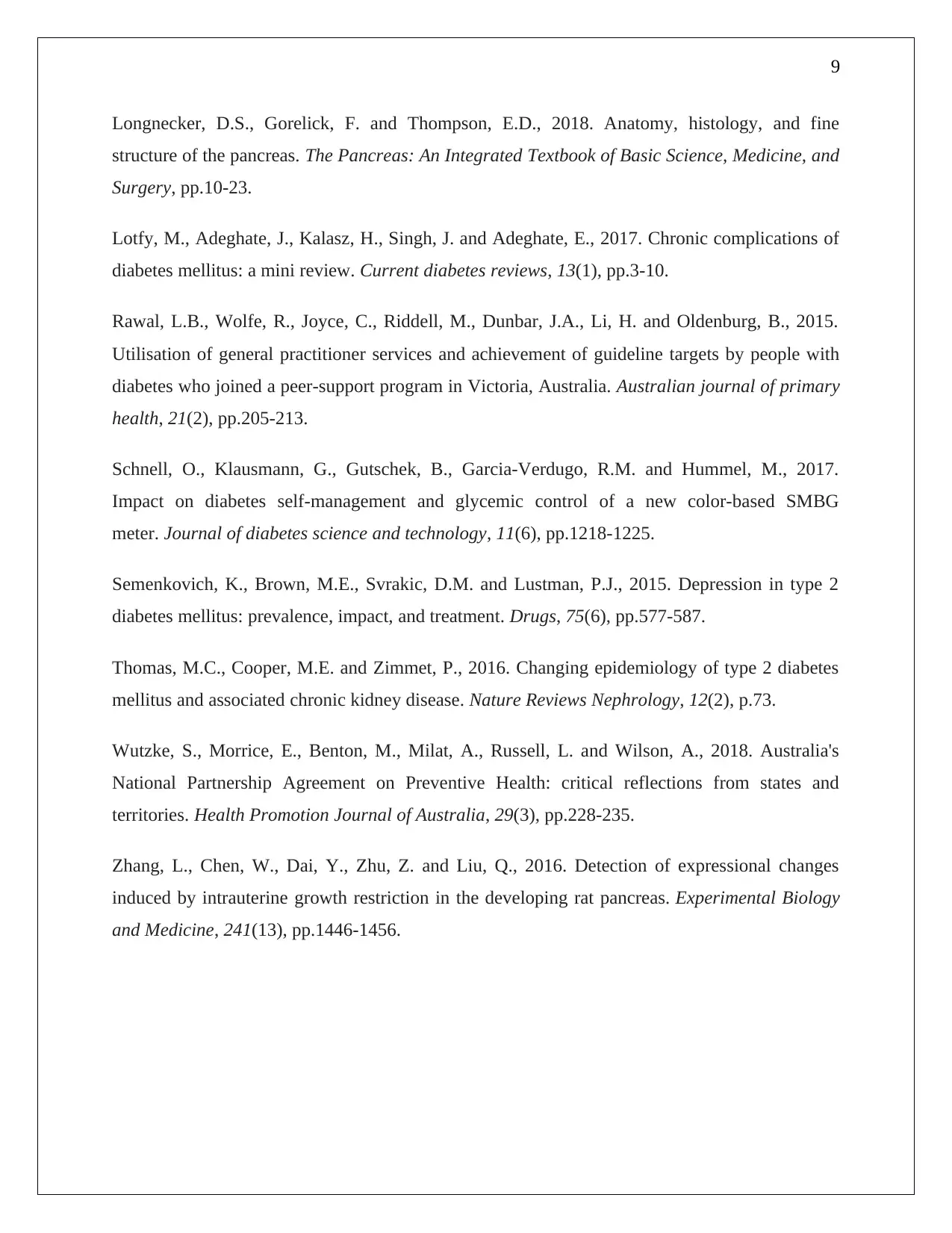
9
Longnecker, D.S., Gorelick, F. and Thompson, E.D., 2018. Anatomy, histology, and fine
structure of the pancreas. The Pancreas: An Integrated Textbook of Basic Science, Medicine, and
Surgery, pp.10-23.
Lotfy, M., Adeghate, J., Kalasz, H., Singh, J. and Adeghate, E., 2017. Chronic complications of
diabetes mellitus: a mini review. Current diabetes reviews, 13(1), pp.3-10.
Rawal, L.B., Wolfe, R., Joyce, C., Riddell, M., Dunbar, J.A., Li, H. and Oldenburg, B., 2015.
Utilisation of general practitioner services and achievement of guideline targets by people with
diabetes who joined a peer-support program in Victoria, Australia. Australian journal of primary
health, 21(2), pp.205-213.
Schnell, O., Klausmann, G., Gutschek, B., Garcia-Verdugo, R.M. and Hummel, M., 2017.
Impact on diabetes self-management and glycemic control of a new color-based SMBG
meter. Journal of diabetes science and technology, 11(6), pp.1218-1225.
Semenkovich, K., Brown, M.E., Svrakic, D.M. and Lustman, P.J., 2015. Depression in type 2
diabetes mellitus: prevalence, impact, and treatment. Drugs, 75(6), pp.577-587.
Thomas, M.C., Cooper, M.E. and Zimmet, P., 2016. Changing epidemiology of type 2 diabetes
mellitus and associated chronic kidney disease. Nature Reviews Nephrology, 12(2), p.73.
Wutzke, S., Morrice, E., Benton, M., Milat, A., Russell, L. and Wilson, A., 2018. Australia's
National Partnership Agreement on Preventive Health: critical reflections from states and
territories. Health Promotion Journal of Australia, 29(3), pp.228-235.
Zhang, L., Chen, W., Dai, Y., Zhu, Z. and Liu, Q., 2016. Detection of expressional changes
induced by intrauterine growth restriction in the developing rat pancreas. Experimental Biology
and Medicine, 241(13), pp.1446-1456.
Longnecker, D.S., Gorelick, F. and Thompson, E.D., 2018. Anatomy, histology, and fine
structure of the pancreas. The Pancreas: An Integrated Textbook of Basic Science, Medicine, and
Surgery, pp.10-23.
Lotfy, M., Adeghate, J., Kalasz, H., Singh, J. and Adeghate, E., 2017. Chronic complications of
diabetes mellitus: a mini review. Current diabetes reviews, 13(1), pp.3-10.
Rawal, L.B., Wolfe, R., Joyce, C., Riddell, M., Dunbar, J.A., Li, H. and Oldenburg, B., 2015.
Utilisation of general practitioner services and achievement of guideline targets by people with
diabetes who joined a peer-support program in Victoria, Australia. Australian journal of primary
health, 21(2), pp.205-213.
Schnell, O., Klausmann, G., Gutschek, B., Garcia-Verdugo, R.M. and Hummel, M., 2017.
Impact on diabetes self-management and glycemic control of a new color-based SMBG
meter. Journal of diabetes science and technology, 11(6), pp.1218-1225.
Semenkovich, K., Brown, M.E., Svrakic, D.M. and Lustman, P.J., 2015. Depression in type 2
diabetes mellitus: prevalence, impact, and treatment. Drugs, 75(6), pp.577-587.
Thomas, M.C., Cooper, M.E. and Zimmet, P., 2016. Changing epidemiology of type 2 diabetes
mellitus and associated chronic kidney disease. Nature Reviews Nephrology, 12(2), p.73.
Wutzke, S., Morrice, E., Benton, M., Milat, A., Russell, L. and Wilson, A., 2018. Australia's
National Partnership Agreement on Preventive Health: critical reflections from states and
territories. Health Promotion Journal of Australia, 29(3), pp.228-235.
Zhang, L., Chen, W., Dai, Y., Zhu, Z. and Liu, Q., 2016. Detection of expressional changes
induced by intrauterine growth restriction in the developing rat pancreas. Experimental Biology
and Medicine, 241(13), pp.1446-1456.
1 out of 10
Related Documents
Your All-in-One AI-Powered Toolkit for Academic Success.
+13062052269
info@desklib.com
Available 24*7 on WhatsApp / Email
![[object Object]](/_next/static/media/star-bottom.7253800d.svg)
Unlock your academic potential
© 2024 | Zucol Services PVT LTD | All rights reserved.





